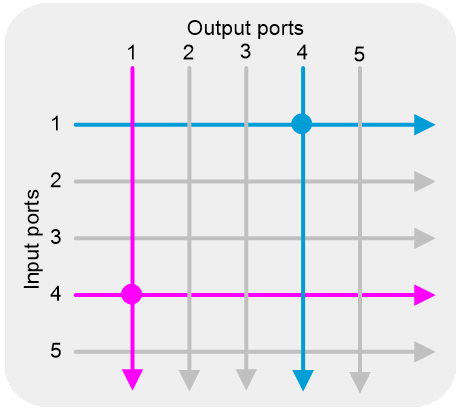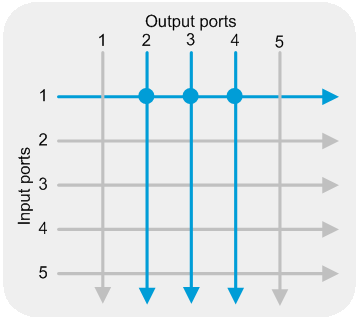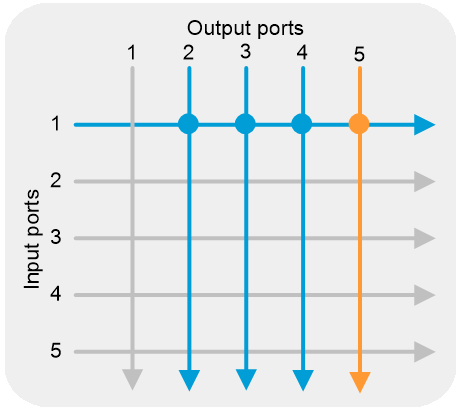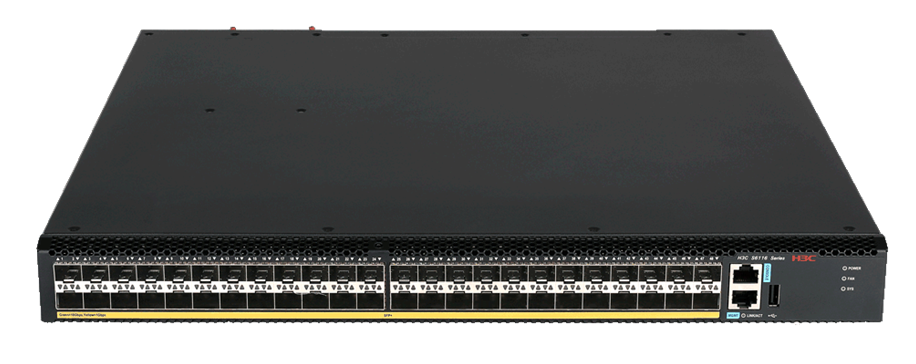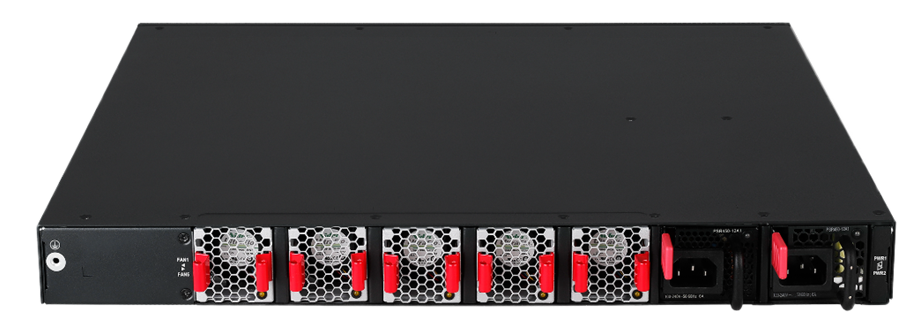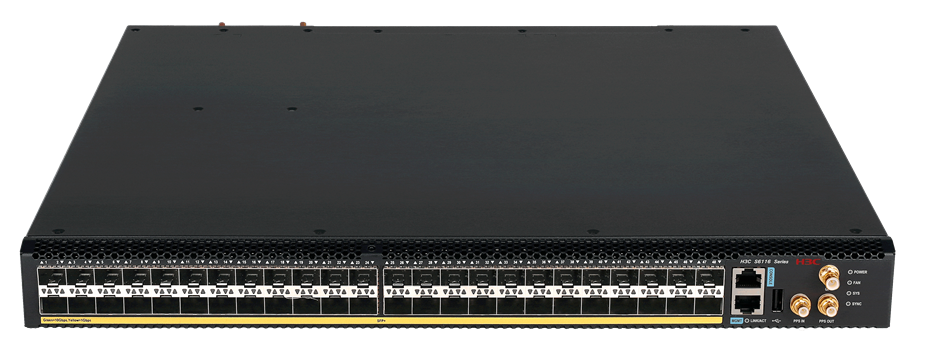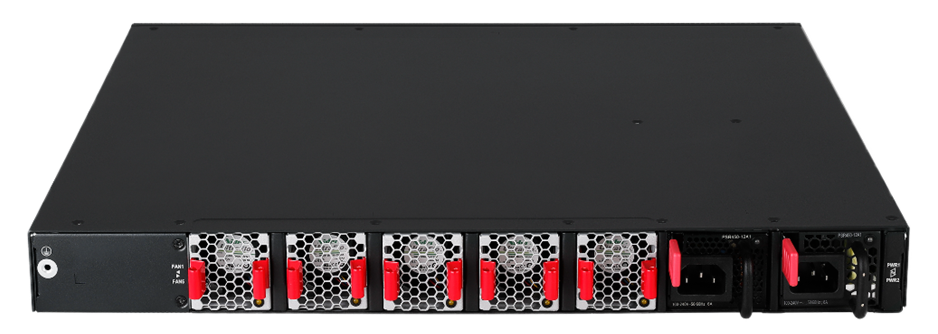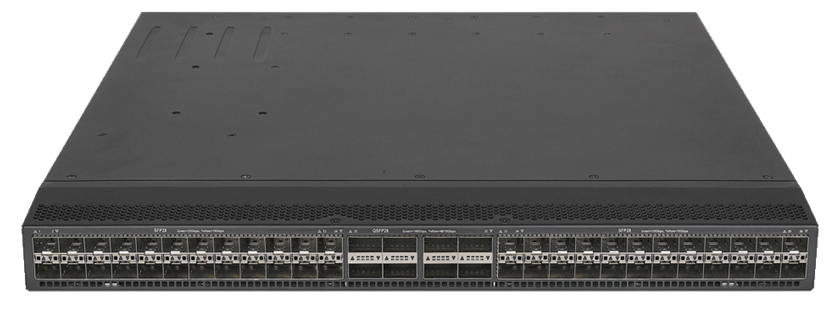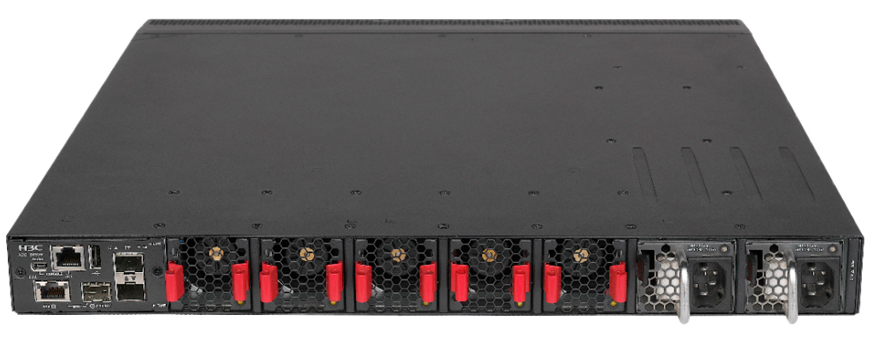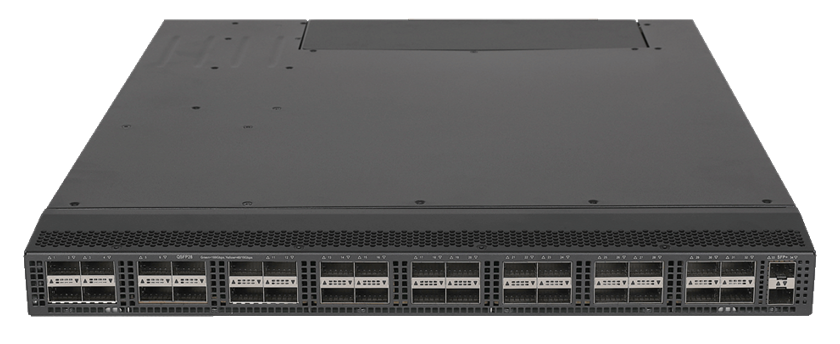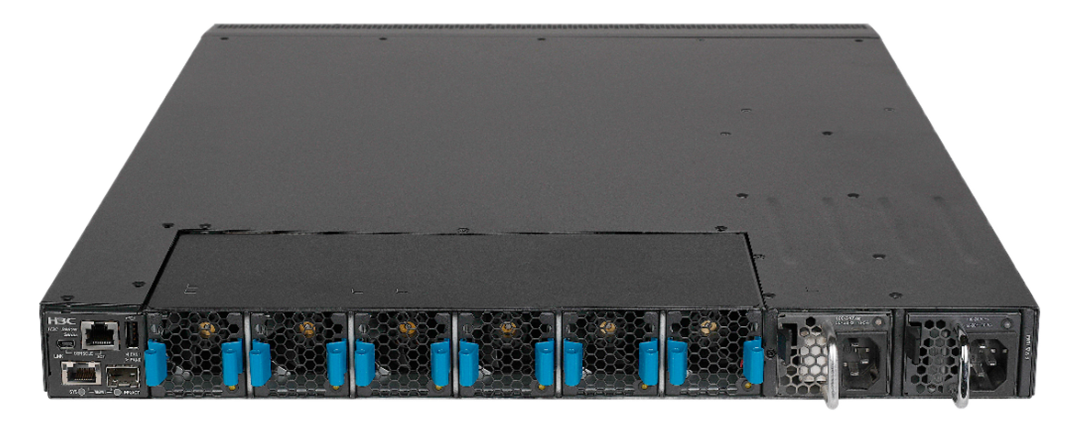| Title | Size | Downloads |
|---|---|---|
| H3C Low-Latency Switch Technology White Paper-6W100-book.pdf | 1.82 MB |
- Table of Contents
- Related Documents
-
| Title | Size | Download |
|---|---|---|
| book | 1.82 MB |
H3C Low-Latency Switch
Technology White Paper
Copyright © 2023 New H3C Technologies Co., Ltd. All rights reserved.
No part of this manual may be reproduced or transmitted in any form or by any means without prior written consent of New H3C Technologies Co., Ltd.
Except for the trademarks of New H3C Technologies Co., Ltd., any trademarks that may be mentioned in this document are the property of their respective owners.
The information in this document is subject to change without notice.
Contents
Typical networking applications
Low-latency technology overview
S6116 Layer 1 and Layer 1.5 low-latency switches
S6826& S9826 Layer 3 low-latency switch
Overview
Background
With the advancement of computer technology and financial technology, high-frequency trading (HFT) is becoming increasingly popular in financial markets and has gradually become the main profit contributor for many trading firms. The trading volume of HFT contributes to more than 60% of the total trading volume in some regions.
The characteristics of high-frequency trading are rapid order placement and cancellation, short holding time, and high demand for low latency in the trading process. In a constantly changing market environment, investors who see market changes faster and transmit trading instructions faster will gain an advantage. Therefore, low-latency trading networks have become an urgent need for high-frequency trading investors.
Based on more than 20 years of deep accumulation in the field of Ethernet switch technology and an in-depth understanding of low-latency trading networks for financial securities companies, H3C has developed Layer 1 and Layer 1.5 low-latency S6116 series switches and Layer 3 low-latency S6826 and S9826 switches. These switches can provide end-to-end ultra-low-latency networking solutions for financial clients.
The S6116 series switches can achieve a low latency of 4 nanoseconds (ns), as apposed to 500 ns for traditional switches. The S6826 and S9826 switches provide rich Layer 2 and Layer 3 features while offering low latency forwarding.
Typical networking applications
The securities and futures trading network is in a continuous evolution. Traditional trading networks generally use Layer 3 switches. The per-hop forwarding latency is up to 1 microsecond, and the end-to-end latency is several hundred microseconds. Replacing the traditional Layer 3 switches with low-latency Layer 3 switches can greatly reduce network forwarding latency. If the network architecture is further changed and ultra-low latency Layer 1 and Layer 1.5 switches are introduced, network latency can be further reduced, providing customers with optimal network services.
Figure 1 shows two low-latency network diagrams, and actual network deployment is more complex.
· In the left diagram, organizations and exchanges are connected through Layer 3 switches, and market data distribution uses Layer 1 switches, while trading uses Layer 2 switches. This solution can combine the benefits of low latency and Layer 3 features.
· In the right diagram, organizations and exchanges are connected through Layer 1.5 switches, and market data distribution uses Layer 1 switches, while trading uses Layer 1.5 switches. This solution can achieve an ultimate low-latency experience.
Figure 1 Low-latency network diagrams
Low-latency technology overview
Layer 1 Ethernet switch
Traditional Layer 2 and Layer 3 Ethernet switches need to look up MAC address tables and routing tables to find the output interfaces, so the latency is typically longer than 500 ns. The H3C S6116-48X Layer 1 Ethernet switch works at the physical layer, and can quickly forward and copy packets based on user configuration, with latency as low as 4 ns. The S6116-48X Ethernet switch supports signal regeneration and enhancement, and supports interface-based statistics for Ethernet packets. The switch combines the benefits of both ultra-low latency and maintainability of normal Ethernet switches.
The S6116-48X switch supports the following Layer 1 features:
· Patch panel: Enables traffic exchange between two interfaces.
· Fan-out: Enables 1:N copying of traffic.
· Tapping: Enables traffic monitoring on interfaces.
Patch panel
Configuring this feature on Layer 1 switches allows bidirectional traffic between any two interfaces, meaning any packets received from one interface will be directly forwarded to the other interface. As shown in Figure 2, after you configure this feature for port 1 and port 4, any packets received from one port will be directly forwarded to the other port.
Fan-out
In situations where the same packet needs to be sent to multiple receivers, such as sending rapidly changing market data to multiple servers, traditional switches and routers broadcast packets on multiple ports in a specific VLAN, or send them to a subset of ports through multicast. These two methods take at least 500 ns of latency.
Layer 1 Ethernet switches implement fast 1:N traffic replication through the Fan-out feature, which quickly duplicates traffic from one port to multiple ports, with latency as low as 4 ns. Layer 1 Ethernet switches support physical signal regeneration and clock data recovery, ensuring data integrity even after multiple copies. As shown in Figure 3, configuring the Fan-out feature can duplicate traffic from port 1 to ports 2, 3 and 4.
Tapping
This feature mirrors traffic received from a port to other ports, allowing financial customers to save transaction data in real time for monitoring and tracking purposes.
As shown in Figure 4, configuring this feature can mirror traffic from port 1 to port 5.
Layer 1.5 Ethernet switch
When multiple servers share a single connection, an FPGA application can be used for link multiplexing and demultiplexing to manage the traffic sent and received by the servers. The FPGA application is known as a multiplexer or Mux.
In addition to all features supported by Layer 1 switches, the S6116-48X-M switch supports FPGA cards and can load multiple FPGA applications.
The S6116-48X-M switch supports the following FPGA applications:
· FastMux: Supports four Mux groups, implementing 15:1, 15:1, 7:1, and 7:1 upstream multiplexing with a minimum latency of 35 ns.
|
|
NOTE: N:1 multiplexing means that a Mux group contains N+1 ports (N downstream ports plus one upstream port). |
· SecurityMux: Supports one Mux group with one upstream port. This FPGA application supports a maximum upstream multiplexing of 47:1 and a maximum downstream demultiplexing of 1:47, with ACL-based forwarding control at the egress port and a minimum latency of 59 ns.
· Enhanced SecurityMux: Supports one Mux group with two upstream ports. This FPGA application supports a maximum upstream multiplexing of 46:2 and a maximum downstream demultiplexing of 2:46, and supports ACL-based traffic forwarding control at the egress port.
· Tapping Aggregation: Supports high-precision timestamping and a 32 GB cache, and can mirror transaction data with timestamps to egress ports. A maximum of four monitoring egress ports can be configured for load balancing of mirrored traffic.
FastMux
FastMux is a feature designed for applications that require ultra-low latency. The downstream traffic is broadcasted by Layer 1 fan-out and does not require FPGA processing. The upstream traffic is multiplexed by the FPGA (with a minimum latency of 35 ns). The device supports the configuration of four groups of Mux under the FastMux mode, and the software design is highly flexible, allowing for dynamic adjustment of port grouping according to the needs.
Figure 5 S6116-48X-M FastMux group diagram
|
|
NOTE: In the diagram, four Mux groups exist: 15:1, 15:1, 7:1, and 7:1. |
SecurityMux
SecurityMux is a feature designed for secure data forwarding. The upstream traffic is multiplexed with a maximum ratio of 47:1 based on FPGA, and the scheduling function is also implemented by FPGA. The downstream traffic is demultiplexed by FPGA and supports ACL filtering based on the egress port.
Figure 6 S6116-48X-M SecurityMux data forwarding diagram
|
|
NOTE:
|
Demux can control data forwarding by using ACLs. ACL rules can be flexibly defined based on source IP address, source port, destination IP address, destination port, and TCP/UDP five-tuple. A maximum of eight ACL rules can be applied to one interface.
Enhanced SecurityMUX
Enhanced SecurityMux operates on the same principle as SecurityMux, and is a feature designed for secure data forwarding. The upstream traffic is multiplexed with a maximum ratio of 46:2 based on FPGA, and the scheduling function is also implemented by FPGA. The downstream traffic is demultiplexed by FPGA. ACLs can be used to control packet forwarding on the egress port of the upstream or downstream traffic.
Tapping aggregation
This feature is designed to support data mirroring. This feature mirrors and timestamps the packets of one or more ports, and aggregates them into up to four monitoring ports for forwarding and backup purposes. Load sharing is supported among multiple monitoring ports.
Open expansion platform
The H3C S6116-48X-M Layer 1.5 low-latency switch supports up to 2 FPGA expansion cards and provides an FPGA development kit (FDK). Users can run their own developed applications on the second FPGA expansion card, which can achieve functions such as electronic trading algorithms, trading strategies, and risk management. Compared with applications running on a server, applications running directly on FPGA have faster response times and lower latency.
Layer 3 low-latency switch
Layer 3 low-latency switches play an important role in ultra-low-latency networking solutions. H3C chose streamlined-design and low-latency switching chips, and conducted in-depth design optimizations for software and hardware to develop S6826 and S9826 low-latency Layer 3 switches. The S6826 and S9826 switches minimize the forwarding latency without impacting Layer 2 and Layer 3 functions, reducing the Layer 2 and Layer 3 forwarding latency to lower than 500 ns. In high-speed trading scenarios for securities firms, funds, exchanges, futures, and other customers, Layer 3 low-latency switches can effectively improve user experience.
Low-latency switch overview
H3C is keeping up with the times and building ultra-low-latency network platforms, providing a relatively complete low-latency network overall solution.
Figure 7 Switch specifications
|
Item |
Layer 1 low-latency switch |
Layer 1.5 low-latency switch |
Layer 3 low-latency switch |
|
Switch model |
S6116-48X |
S6116-48X-M |
S9826-32C S6826-48Y8C |
|
Supported features |
· Patch panel · Fan-out 1:N · Tapping |
· Patch panel · Fan-out 1:N · Tapping · FastMux · SecurityMux · Tapping aggregation |
Features supported by Layer 3 low-latency switches |
|
Forwarding latency |
< 4 ns |
FastMux: < 45 ns (35 ns minimum) SecurityMux · Mux upstream: ≤ 76 ns · Demux downstream: ≤ 80 ns (60 ns minimum if ACLs are configured) |
500 ns |
|
Ports supported |
48 SFP+ ports |
48 SFP+ ports |
S6826-48Y8C: 48*SFP28+8*QSFP28+2*SFP S9826-32C: 32 32*QSFP28+2*SFP+ |
S6116 Layer 1 and Layer 1.5 low-latency switches
The S6116 series of low-latency Ethernet switches is a high-density 10G switch series developed for financial, securities, and other scenarios, which can achieve nanosecond-level low-latency forwarding capabilities.
Figure 8 S6116-48X Layer 1 low-latency switch
Figure 9 S6116-48X-M Layer 1.5 low-latency switch
This series of switches has the following features:
· Nanosecond-level low-latency forwarding capabilities: The S6116-48X Layer 1 switch has a minimum forwarding latency of 4 ns, and the Layer 1.5 switch can achieve a minimum forwarding latency of 35 ns, reaching the best forwarding performance among Layer 1.5 switches in the industry.
· High-density 10G ports: The S6116-48X switch supports a maximum of 48 ports, and supports standard SFP+ access ports. Each 10G port supports 1G adaptive rate.
· High expansion capability: The S6116-48X-M switch supports FPGA expansion cards, provides FDKs, and enables financial customers to develop their own FPGA applications and run their own trading and risk management strategies.
· Multiple clock synchronization methods: The S6116-48X-M switch supports high-precision clocks, supports clock input methods such as GPS, 1PPS, PTP, and NTP, and supports 1PPS clock output.
· Excellent management capability: Supports rich management interfaces, supports SNMPv1/v2/v3, industry-standard network management platforms, and iMC, supports the CLI, supports Telnet and FTP, and supports SSH2.0 encryption. Supports controlling access to management interfaces by using ACLs.
· The interface traffic statistics interval is 5 seconds to support fine-grained monitoring.
· Supports plug-in power supplies and fans, with flexible wind direction selection.
S6826& S9826 Layer 3 low-latency switch
The S6826&S9826 series switches are designed for high-density 25GE/100GE access and aggregation in the financial and securities network, with the lowest Layer 2 and Layer 3 forwarding latency of lower than 500 ns.
Figure 10 S6826-48Y8C Layer 3 low-latency switch
Figure 11 S9826-32C Layer 3 low-latency switch
The S6826 and S9826 Layer 3 low-latency switches have the following benefits:
· Low latency: The minimum latency for Layer 2 and Layer 3 forwarding is lower than 500 ns, which fully meets the demand for end-to-end low-latency forwarding.
· Supports high-density and flexible 100GE/40GE/25GE/10GE port configurations, as well as standard 25G access ports, with high port density and powerful forwarding capabilities.
· Excellent management capabilities: Supports various management interfaces, such as console port, management Ethernet port, mini-USB port, and USB port. Supports SNMPv1/v2/v3, which can be compatible with industry-standard network management platforms and iMC. Supports the CLI, supports Telnet and FTP, and supports SSH2.0 encryption.
· Multiple reliability protection: Equipped with device-level protection technologies such as overcurrent protection, overvoltage protection, and overheating protection, as well as link-level protection technologies such as RRPP.
· Supports plug-in power supplies and fans, with flexible wind direction selection.


